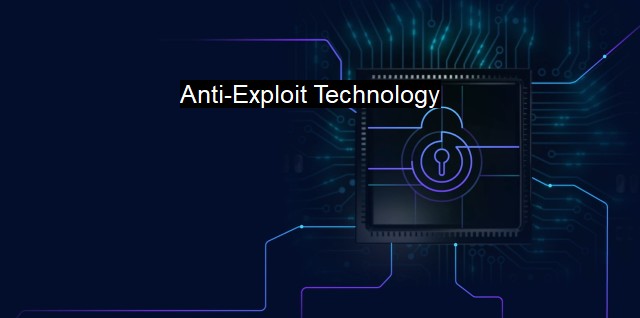What is Anti-Exploit Technology?
The Importance of Anti-Exploit Technology in Ensuring Cybersecurity and Prevention of Software Vulnerabilities
Anti-exploit technology is an essential aspect of cybersecurity, focusing significantly on battling threats that often slip unnoticed past conventional antivirus programming. It functions by detecting and blocking exploit attempts, which refer to cleverly designed efforts by cybercriminals to manipulate and capitalize on software vulnerabilities. To comprehend its importance, it is fundamental to grasp what an exploit is in the first place.An exploit is a tactic used by hackers to take advantage of a software vulnerability or fault. Vulnerabilities can exist in any software, ranging from your operating system to a simple email client or even a media player. For instance, your browser could unexpectedly execute destructive HTML code – a browser exploit, or your document reader may interpret particular contents in a manner that allows harmful software to infiltrate your system – a document reader exploit. Exploits can also result from faulty hardware configurations.
While antivirus solutions primarily deal with known malware threats, they can struggle to defend against unknown or zero-day exploits. Zero-day vulnerabilities signify newly discovered weaknesses that hackers can take advantages of before developers compose a patch, hence 'zero day'. Here is where anti-exploit technologies showcase their utmost importance.
Anti-exploit technology uses various methods to offer an additional protection layer against exploitation. Specifically, it identifies and neutralizes common techniques that exploits invoke, rather than trying to counter the thousands of individual exploits. These techniques may comprise manipulating data structures, launching shellcode, or return-oriented programming (ROP), among others.
To counter such techniques, anti-exploit apps typically utilise memory-based capabilities such as Address Space Layout Randomization (ASLR), Structured Exception Handler Overwrite Protection (SEHOP), and Data Execution Prevention (DEP). they leverage behavioral-based protection steps like API caller verification, stack pivot protection, and memory Callable and Payload protection, which further enhances resilience against these threats.
One prominent feature of anti-exploit technology is that it operates in real-time. This means it can warn the user and block exploit activities as they occur before they inflict any damage, unlike conventional antivirus software that might only alert the users after the system becomes infected. it proactively shields applications, particularly those inherently insecure due to frequent interaction with the internet, providing an extra layer of defense against potential threats.
Simultaneously, anti-exploit packages aim to secure often exploited software such as web browsers, Java, Adobe Reader, Microsoft Office, and media files that can expose your computer to a high attack surface. They can quarantine and identify potentially risky elements, ensuring that malicious entities don't exploit any accidental or intentional user actions that may put system integrity at risk.
It's important to note that anti-exploit technology isn't a stand-alone solution. Integrated well within a multi-layered security system, involving firewalls, intrusion detection, antivirus, and anti-malware solutions, this breed of protection serves as an additional, pivotal layer rather than substituting any existing measures. One can think of it as frailty patching: it offers temporary and prompt protection to the weak spaces within codes, thus decreasing the 'window of opportunity' for exploits.
Understanding the ecosystem of cyber threats, anti-exploit technology stands out as a crucial player. As the prevalence of zero-day and unidentified attacks proceeds to rise, the anti-exploit technology's role is significantly underscoring as an efficiently proactive approach to blanket device protection. it isn't a silver bullet solution. It emerges as one answer amongst the myriad resources focusing on one goal: securing users' digital universe efficiently.
Anti-exploit technology adds a new dimension to the modern warriors' arsenal—those battling in the ongoing and increasingly sophisticated conflict in cybersecurity. Through forethought, vigilance, coordination of other security mechanisms, it aims to keep not only individual systems secure but also the broader digital world we inhabit and rely upon every day.

Anti-Exploit Technology FAQs
What is anti-exploit technology?
Anti-exploit technology is a type of cybersecurity technology that is designed to prevent the exploitation of vulnerabilities in software or systems. It detects and prevents attackers from exploiting vulnerabilities in software that could otherwise be used to gain unauthorized access, steal data, or spread malware.How does anti-exploit technology work?
Anti-exploit technology works by proactively scanning for vulnerabilities in software and systems. Once a vulnerability is detected, it prevents the exploitation of that vulnerability by blocking the attack vector or shutting down the attacked process. It does this by using advanced heuristics and behavior analysis to identify and block malicious code before it can execute.How effective is anti-exploit technology compared to traditional antivirus software?
Anti-exploit technology is more effective than traditional antivirus software because it does not rely on signature-based detection, which can be easily bypassed by attackers using new or modified attacks. Anti-exploit technology is proactive and can detect and block zero-day attacks, where no signatures are available. It provides a comprehensive layer of protection against targeted and advanced attacks that traditional antivirus software may miss.What are some examples of anti-exploit technology?
Some examples of anti-exploit technology are Microsoft's EMET (Enhanced Mitigation Experience Toolkit), Malwarebytes Anti-Exploit, and Cisco AMP (Advanced Malware Protection) for Endpoints. These tools provide a proactive layer of protection against zero-day attacks and can be used in conjunction with traditional antivirus software for added protection.| | A | | | B | | | C | | | D | | | E | | | F | | | G | | | H | | | I | | | J | | | K | | | L | | | M | |
| | N | | | O | | | P | | | Q | | | R | | | S | | | T | | | U | | | V | | | W | | | X | | | Y | | | Z | |
| | 1 | | | 2 | | | 3 | | | 4 | | | 7 | | | 8 | | |||||||